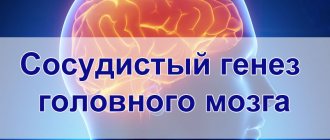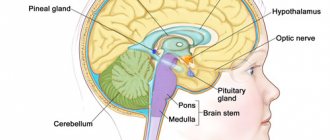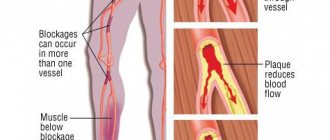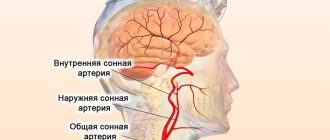Diagnostic measures for amyloid angiopathy
Amyloid is a kind of protein substance - a glycopeptide, that is, a complex that consists of polysaccharides and proteins. The components of amyloid are very strong, so this substance is practically unaffected.
Today, the following research methods exist to make and confirm a diagnosis:
- CT visualization of hemorrhages in the cerebral cortex characteristic of amyloid angiopathy. which is considered the method of choice in determining acute cortical hemorrhages.
- MRI diagnostics of ischemic foci and minor hemorrhages.
- Brain biopsy is the definitive method for diagnosing amyloid angiopathy, but is rarely used.
Causes of the disease
The development of microangiopathy occurs against the background of other diseases. This could be diabetes mellitus, oncology, liver pathology, hemolysis.
Among the main reasons are the following:
- viral infections (measles, rubella);
- pathologies that contribute to blood damage;
- diabetes;
- hypertension;
- elderly age;
- hereditary pathologies that cause vascular tone;
- various injuries;
- severe intoxication;
- abuse of bad habits.
Most often, pathology develops as a result of the following processes:
- Necrosis is the death of tissues and cells of the body.
- Hyalinosis is a lack of protein due to hyaline deposition.
- Increased vascular permeability. As a result, the fibers and structural elements of connective tissue undergo irreversible changes.
- Thrombosis, characterized by the formation of a blood clot in the lumen of a vessel, resulting in impaired blood flow.
- Dysfunction of the vascular endothelium, which leads to their spasm. In this condition, the production of antithrombin and prostacyclin decreases, and the concentration of thromboxane increases.
Cerebral angiopathy: brain, blood vessels, what is it?
Cerebral angiopathy is a pathological condition characterized by disruption of the blood vessels of the brain.
This leads to a discrepancy between tissue oxygen consumption and the ability of damaged veins and arteries to supply this vital element. Hypoxia develops.
Nerve fibers are extremely sensitive to decreased oxygen levels, so even a short-term decrease in tissue saturation with this element leads to cell death.
This causes an increase in neurological disorders.
In most cases, such abnormalities in the functioning of the vessels that feed the brain tissue begin to appear in a mild form in people starting at the age of 30.
Depending on the severity of the influence of unfavorable factors that caused the development of this pathological process, disturbances can increase both quite slowly and very intensively.
Causes of cerebral angiopathy
Damage to blood vessels located in the brain is detected in approximately 30% of patients suffering from chronic cardiac pathologies. Most often, cerebral angiopathy occurs against the background of hypertension and atherosclerosis. In addition, such circulatory disorders in the brain can occur as a result of the progression of diabetes mellitus and amyloidosis.
In addition, there are a number of predisposing factors that can create the prerequisites for the appearance of cerebral angiopathy, including:
- metabolic disease;
- blood poisoning;
- autoimmune diseases;
- elderly age;
- smoking;
- alcohol abuse;
- passive lifestyle;
- traumatic brain injuries;
- avitaminosis;
- obesity.
In addition, the existing anatomical features of the structure of blood vessels significantly contribute to the development of cerebral angiopathy. Improper nutrition can create the preconditions for the development of a pathological condition. Dishes high in salt are especially dangerous.
Among other things, intoxication of the body can create the preconditions for the appearance of a condition such as cerebral angiopathy. The risk group includes people who work in hazardous industries. In addition, the risk of developing this disorder is higher in people who have a hereditary predisposition to this pathology.
If there are cases of acute cerebral vascular damage in the family history, the likelihood of such a problem reaching 50%.
Symptoms of cerebral angiopathy
For a long time, this pathological condition may not manifest itself with pronounced symptoms.
The severity of symptoms largely depends on how damaged the blood vessels supplying the brain tissue are. For a long time, such a violation may go unnoticed.
At first, cerebral vascular angiopathy manifests itself as periodic discomfort and attacks of headache.
https://www.youtube.com/watch?v=E1eiw-5pwwI
Subsequently, people suffering from this pathology begin to complain of a significant decrease in vision and hearing.
With significant damage to brain structures due to disruption of their oxygen supply, the ability to concentrate is reduced. In addition, cases of loss of the sense of space and time are becoming increasingly common. Such attacks are usually short-lived. Subsequently, psychomotor disorders increase. Short-term memory loss may occur.
Relatives of such patients often note changes in behavior and personality structure. People suffering from a disorder called cerebral angiopathy usually become overly irritable. The ability to tolerate loud noises decreases. In addition, attacks of photophobia are possible. There are frequent mood changes.
Damage to brain tissue can cause the development of any type of sensory impairment, even to complete paralysis. In especially severe cases, patients suffering from cerebral angiopathy experience very realistic hallucinations.
With such an unfavorable course, even complex treatment does not eliminate the existing neurological problems.
In the later stages of the pathological process, headaches become very frequent. In addition, attacks of dizziness are constant companions in the patient’s life. Damage to blood vessels leading to the brain predisposes to bleeding. Hemorrhagic strokes in people suffering from cerebral angiopathy have an extremely unfavorable outcome in 90% of cases.
Damage to the blood vessels of the brain poses a serious danger to a person’s overall health. If it was not detected in a timely manner and adequate treatment was not started, there is a high probability of early disability.
Diagnosis of cerebral angiopathy
Cerebral circulatory disorders of this type are quite easy to identify using modern diagnostic methods. To determine the symptoms of vasopathy, biochemical tests of blood and urine are first prescribed.
In addition, tests to determine lipid levels may be indicated. X-rays are required.
In addition, patients with suspected macroangiopathy may be prescribed a contrast ultrasound examination.
It is possible to identify the most damaged areas of the blood vessels of the brain and its tissues using such modern research methods as magnetic resonance imaging. This method allows you to determine even signs of microangiopathy.
Angiography is performed to make an accurate diagnosis. Only after conducting a complex of studies can a significant improvement in the condition be achieved. When doctors suspect a patient has amyloidosis, a brain biopsy may be necessary. This is an invasive research method that involves taking tissue for further histological examination.
Treatment of cerebral angiopathy
This pathological condition is extremely dangerous, as it leads to the development of very severe complications and irreversible neurological disorders, so under no circumstances should things be left to chance.
Complex medical and sometimes surgical treatment is required.
The choice of treatment methods largely depends on the cause of the cerebrovascular accident and the severity of the symptoms. First of all, medications are selected to thin the blood and eliminate possible blood clots.
Treatment of this pathological condition is carried out by using agents that help strengthen the walls of blood vessels.
If the patient adheres to drug therapy, antispasmodics, nonsteroidal anti-inflammatory drugs, and vitamin complexes may also be prescribed.
When conservative treatment does not provide good results, surgery may be prescribed. Many methods have been developed to expand the lumens of affected vessels. Using cylinders and special nets.
Resection of the affected area or placement of a shunt may be performed to allow blood to bypass the blocked area. Surgery usually gives good results in such pathological conditions as cerebrovascular insufficiency.
Thanks to the restoration of blood flow, there is a rapid improvement in the general condition, and sometimes the restoration of lost neurological functions and an increase in brain activity.
Source: https://krov.expert/zabolevaniya/angiopatiya-tserebralnaya.html
Clinical picture
Mild cerebral amyloid angiopathy in most cases is characterized by an asymptomatic course; subsequently, clinical symptoms are caused by small cortical infarcts, lobar hemorrhages, and transient ischemia of the cerebral cortex.
Cognitive and neurological symptoms are observed:
- epileptic seizures;
- Visual impairment;
- muscle weakness, localized in the extremities;
- periodic numbness of the legs and arms;
- paresthesia (spontaneous burning, tingling, sensation of “pins and needles”);
- slowing down mental reactions.
With this pathological process, hemorrhages are localized in the lobar part of the brain, especially often in the parietal, frontal and parieto-occipital regions. Moreover, these hemorrhages are characterized by the absence of cerebral symptoms, which is why they are mistakenly mistaken for an ischemic stroke.
Cerebral amyloid angiopathy is characterized by frequent repeated hemorrhages. Their location changes frequently. Fortunately, these hemorrhages are successfully removed surgically, impaired functions are restored, and deaths are quite rare compared to hemorrhages with arterial hypertension.
Treatment of this pathological condition
This type of angiopathy is considered incurable. The use of basic therapeutic procedures is symptomatic.
Patients do not always understand when they are diagnosed with cerebral microangiopathy, what it is and whether it can be cured. The doctor usually prescribes complex therapy.
First of all, the patient must take medications that normalize blood pressure. To eliminate the lack of oxygen in the brain, antihypoxants are used, for example Emoxipin. It is also important to correct lipid levels using statins, fibrates, and bile acid sequestrants. These may be the following drugs: Atorvastatin, Simvastatin, Rosuvastatin.
Kinds
Angiopathy is caused by damage to small vessels; it comes in two types:
- The walls of the hyaline arteries thicken.
- There is a thickening of the capillary walls.
In both cases, the processes occur due to a lack of cerebral blood supply on an ongoing basis, which leads to damage to neurons. Over time, this can provoke the appearance of lacunar infarction, non-inflammatory brain diseases that are caused by diffuse damage to the organ. Thus, diffuse cerebral angiopathy occurs - damage to all brain vessels in alternating places of healthy and diseased tissue.










